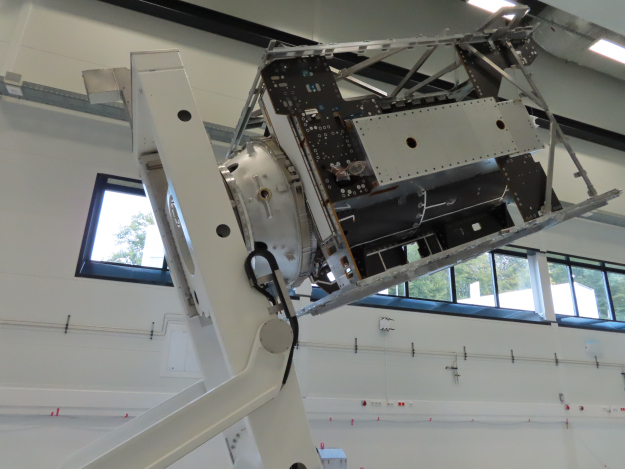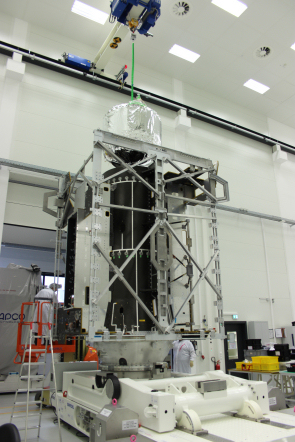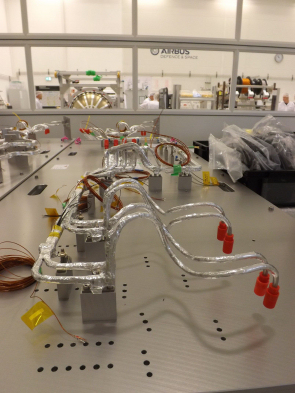#5: JUICE begins to take shape
23 October 2019
The assembly of the flight model of ESA's JUICE spacecraft began in September, with the delivery of the spacecraft's primary structure, followed by integration of the propulsion system that will enable the mission to reach and study Jupiter and its moons. |
| Unpacking of JUICE primary structure in Lampoldshausen. Credit: Courtesy of Airbus and ArianeGroup |
On 2 September, the main skeleton of JUICE was delivered to the Arianegroup facility in Lampoldshausen, Germany.
The primary structure of the spacecraft features a central tube – the main load bearing element – with vertical shear panels located radially around the tube, and horizontal floor panels. This will be completed later with the optical bench and external closing panels that will form the outer walls and will be added when all the internal equipment has been integrated.
The structure is part of the so-called Structure, Shielding and Thermal Subsystem (SSTS), built under the responsibility of Airbus Defence & Space in Madrid, Spain, with participation by RUAG Space Switzerland and RUAG Space Austria.
One of the features of the JUICE SSTS is that the some of the vertical panels and parts of the closing walls of the structure are lined with a thin layer of lead, which provides shielding to protect the spacecraft's electronic systems from damage by the severe radiation environment at Jupiter.
 |
| JUICE propulsion system integration. Credit: Courtesy of Airbus and ArianeGroup |
Over the coming months, five companies will be working almost simultaneously on the STSS in order to ensure that JUICE can proceed to the assembly and integration phase that will take place in Airbus facilities in Friedrichshafen, Germany, so that it will be completed and ready for launch in 2022.
One of the main tasks at Lampoldshausen will be to integrate the propulsion system. This includes two identical propellant tanks that have been newly developed for EuroStar Neo, ESA's new generation of platforms for geostationary telecommunications satellites. JUICE will be the first space mission to actually utilise them.
The first titanium tank, capable of holding 1600 litres of oxidant (mixed oxides of nitrogen, or MON), was carefully lowered inside the spacecraft's central cylinder on 7 September. The second tank, which will contain monomethyl hydrazine (MMH) fuel, is scheduled for installation at the end of October.
"JUICE will need to carry more than 3000 kg of propellant in these tanks," said Daniel Escolar, ESA's Mechanical, Thermal & Propulsion System Engineer for the mission.
"Such a large load will be essential for JUICE to arrive in orbit around Jupiter and complete its scientific tour with multiple flybys of the Galilean moons, before eventually becoming the first spacecraft ever to enter orbit around Ganymede."
 |
| JUICE propulsion system piping. Credit: Courtesy of ArianeGroup |
The integration of the spacecraft's propulsion system will, however, involve much more than installing two propellant tanks. Eventually, three fairly small tanks, each filled with helium pressurant, will be affixed around the exterior of the central cylinder, together with all the necessary plumbing. Some 130 metres of titanium piping will also have to be installed and welded in the STSS.
Other hardware to be added during installation of the propulsion system will include pressure regulators, valves, filters and thrusters. In addition to its single 400-newton main engine that will be used for the larger orbital manoeuvres, JUICE will carry eight 22-newton thrusters for smaller manoeuvres and as a backup system, along with twelve 10-newton thrusters for attitude control.
Meanwhile, engineers are busy carrying out other essential tasks that can only be completed whilst the external panels are not fitted, enabling easy access to the spacecraft's interior. These include placing single layer insulation around the central cylinder, adding thermocouples to measure temperatures, and attaching support fixtures for the harness that will eventually be required to carry around 10 km of electrical cable.
According to the current schedule, the JUICE flight model will be moved to Friedrichshafen around March next year for integration and testing of its electrical systems.
Meanwhile, development of the JUICE scientific payload is continuing, and the magnetometer boom for the flight model has recently been delivered to ESA's Space Research and Technology Centre in Noordwijk, the Netherlands, for three weeks of vibration and deployment tests.
About JUICE
JUICE – JUpiter ICy moons Explorer – is the first large-class mission in ESA's Cosmic Vision 2015-2025 programme. It will complete a unique tour of the Jupiter system that will include in-depth studies of three potentially ocean-bearing satellites, Ganymede, Europa and Callisto.
The Jupiter tour includes several flybys of each planet-sized world, culminating with orbit insertion around Ganymede, the largest moon in the Solar System, followed by nine months of operations in its orbit.
JUICE will carry the most powerful scientific payload ever flown to the outer Solar System. It consists of 10 state-of-the-art instruments plus one experiment that uses the spacecraft telecommunication system with ground-based instruments.
JUICE's instruments will enable scientists to compare each of these icy satellites and to investigate the potential for such bodies to harbour habitable environments such as subsurface oceans. They will also carry out observations of Jupiter, its atmosphere, magnetosphere, satellites and rings.












